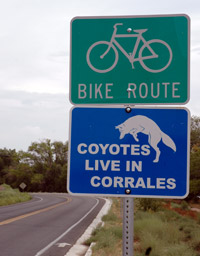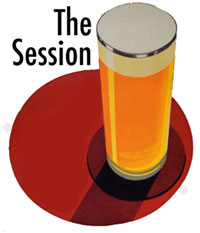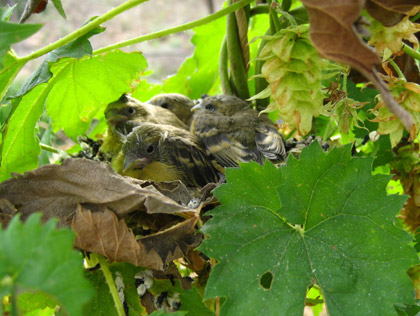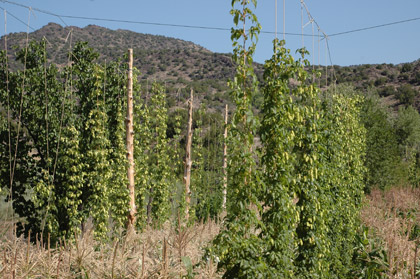The theme for this month’s session is The Brew Zoo. Rick Lyke is your host and will compile the recap.
 I live in a town where (as you can see) visitors are greeted with a sign that touts our coyotes, and this time of year you hear them howling away throughout the night although we don’t see much of them.
I live in a town where (as you can see) visitors are greeted with a sign that touts our coyotes, and this time of year you hear them howling away throughout the night although we don’t see much of them.
But I’ve never been able to buy a Wilie E. Coyote Ale, and I’m still waiting for Cask Corrales Coyote (“Oh, that firkin road runner!”) at the brewery I can walk to.
By the time I’m done typing this entry one or two road runners will have strolled by my office window. Yet I’ve also not met a Road Runner Stout (or IPA).
If you lived in New Mexico wouldn’t you want to be able to buy a coyote or road runner beer? Or even something with Lobos in the name. Lobo Lupilin has a nice ring to it. Were there such a beer, making a choice for this month’s Session would have been so much easier.
Last week I did have a Jack Rabbit IPA at Chama River Brewing. And a jack rabbit will occasionally hop across our yard of sand, rocks and desert sage, but only occasionally. Besides I’ve already written about a couple of Chama beers in past Sessions.
We don’t get many dogs in our yard (dogs wander from their homes at their own coyote risk). Too bad, because what might be New Mexico’s most famous – and this one even comes in a bottle with a label – beer features a bandito dachshund, a cartoon likeness of a dog whose name was Petey. Petey went on a chicken killing spree when Santa Fe Brewing was still operating in the village of Galisteo. When he was done 22 chickens were dead and the brewery had the name for its barley wine.
I judged barley wines (for breakfast) in the recent New Mexico State Fair Pro-Am and it turns out the beer we gave the silver medal to was a 2004 vintage of Chicken Killer – creamy, luscious and full of orchard fruits. But 22 ounces of Chicken Killer (why do so many breweries put their strongest beers in the biggest bottles and everything else is in six-packs?) followed by typing has more appeal sometimes than others.
 Yes, I could celebrate The Session with any of several Flying Dog beers in the garage fridge, or head to a nearby store and find a variety of beers with critters on the labels. (Even a few with critters inside – and The Session seems like a good enough excuse to buy a sixer of Jolly Pumpkin Bam Biere with that Jack Russell on the front. Which it turns out Alan tried for the first time in The Session.)
Yes, I could celebrate The Session with any of several Flying Dog beers in the garage fridge, or head to a nearby store and find a variety of beers with critters on the labels. (Even a few with critters inside – and The Session seems like a good enough excuse to buy a sixer of Jolly Pumpkin Bam Biere with that Jack Russell on the front. Which it turns out Alan tried for the first time in The Session.)
But I’m still thinking local, real local. In fact, I just wanted to see a particular live animal before talking about my animal choice. Anyway, honest, a squirrel finally arrived to steal from one of our bird feeders (aren’t you glad there might finally be a point?). Now we can talk about Fat Squirrel IPA, a beer from Turtle Mountain Brewing. Turtle Mountain is just a couple of miles up the hill from our house, farther if you go by road.
In New Mexico brewing IPAs is a competitive sport, both among amateurs and pros, and Turtle Mountain comes to play. Wednesday there were three IPAs on tap, and Fat Squirrel was available both on draft and cask-conditioned in a firkin. The brewhouse itself smelled of grapefruit and pine, since Centennial hops fresh from the bines and delivered overnight from the Yakima Valley were being added to New Mexico’s first fresh hop beer. (Check back in a few weeks.)
Turtle Mountain describes Fat Squirrel as “in the British style” – but it is more of a hybrid, the Northwest hops muted (at least compared to TMBC IPA) but present. British malts and yeast soften the beer on the palate, but I don’t think Roger Protz would call this a British IPA.
The beer takes its name from when it was first brewed at the original Turtle Mountain pub a few blocks away. One day a then-skinny squirrel was hanging around the back door to the brewery and the brewers offered him some spent grain. At first he’d come running for the treats. Eventually he slowed to a waddle, and there were times he’d loll in the shade of a car out back, looking indifferently at another meal.
The brewery has moved to bigger quarters. The squirrel has disappeared. The legend lives on in the glass.
About the session.
 Rick Lyke has the recap on the 7th round of The Session.
Rick Lyke has the recap on the 7th round of The Session.


 I live in a town where (as you can see) visitors are greeted with a sign that touts our coyotes, and this time of year you hear them howling away throughout the night although we don’t see much of them.
I live in a town where (as you can see) visitors are greeted with a sign that touts our coyotes, and this time of year you hear them howling away throughout the night although we don’t see much of them. Yes, I could celebrate The Session with any of several
Yes, I could celebrate The Session with any of several